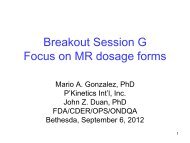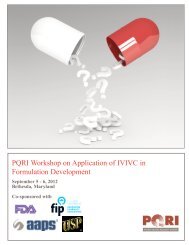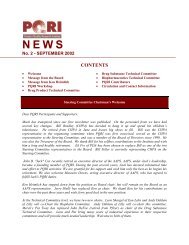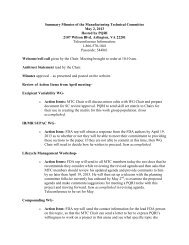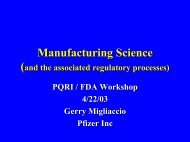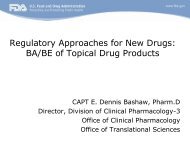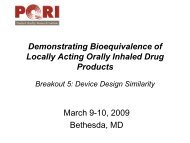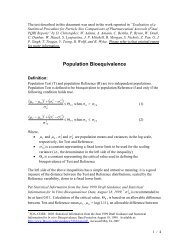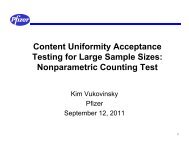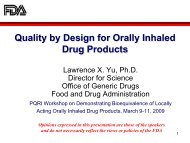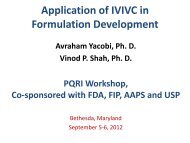Derivation and Justification of Safety Thresholds - PQRI
Derivation and Justification of Safety Thresholds - PQRI
Derivation and Justification of Safety Thresholds - PQRI
- No tags were found...
Create successful ePaper yourself
Turn your PDF publications into a flip-book with our unique Google optimized e-Paper software.
<strong>Derivation</strong> <strong>and</strong> <strong>Justification</strong><br />
<strong>of</strong> <strong>Safety</strong> <strong>Thresholds</strong><br />
Douglas J. Ball, MS, DABT<br />
Chair, <strong>PQRI</strong> L&E Toxicology Subgroup<br />
Research Fellow, <strong>Safety</strong> Sciences - Pfizer, Inc.
Agenda<br />
• Basic Definitions<br />
• Current Regulatory L<strong>and</strong>scape<br />
– FDA Guidance Documents<br />
– ICH Guidance<br />
– EMEA Guidance<br />
• Threshold for Toxicological Concern (TTC)<br />
• IPAC-RS<br />
– Points to Consider Response to FDA Draft Guidance<br />
• <strong>PQRI</strong><br />
– Threshold Approach to Qualify Leachables in OINDP<br />
5 December 2005 <strong>PQRI</strong> L&E Workshop - DJ Ball 2
Definitions<br />
• Container Closure System: Refers to the sum <strong>of</strong><br />
the packaging components that together contain<br />
<strong>and</strong> protect the dosage form. This includes both<br />
primary <strong>and</strong> secondary packaging components.<br />
– packaging system = container closure system<br />
• Container Closure Component: Any single part<br />
<strong>of</strong> a container closure system (metered dose valve,<br />
rubber gasket, etc.)<br />
• Container Closure Material: typically refers to<br />
the material <strong>of</strong> construction (e.g. TPE, PP, rubber,<br />
etc.)<br />
5 December 2005 <strong>PQRI</strong> L&E Workshop - DJ Ball 3
Definitions<br />
• Extractable<br />
– Any chemical species that can be removed from<br />
a packaging component under laboratory<br />
conditions (e.g., component is cut in pieces <strong>and</strong><br />
incubated with solvent).<br />
• Leachable<br />
– An extractable that actually migrates into a<br />
drug product under storage conditions.<br />
5 December 2005 <strong>PQRI</strong> L&E Workshop - DJ Ball 4
L<br />
E1<br />
E3<br />
E2<br />
E4<br />
Shelf Life<br />
E3<br />
E1<br />
E2<br />
E5<br />
E5<br />
L4<br />
L3<br />
Container Component<br />
Time (0)<br />
Container Component<br />
Time (n)<br />
• Not all Extractables are Leachables<br />
• Not all Leachables correlate to Extractables<br />
5 December 2005 <strong>PQRI</strong> L&E Workshop - DJ Ball 5
Laws<br />
• Food, Drug <strong>and</strong> Cosmetic Act Section 501(a)(3)<br />
– a drug is deemed to be adulterated if its container is<br />
composed, in whole or part, <strong>of</strong> any poisonous or<br />
deleterious substance which may render the contents<br />
injurious to health…<br />
– Section 502: a drug is considered misbr<strong>and</strong>ed if there are<br />
packaging omissions.<br />
• 21 CFR Part 211.94 (a)<br />
– Drug product containers <strong>and</strong> closures shall not be<br />
reactive, additive, or absorptive so as to alter the safety,<br />
identity, strength, quality or purity beyond the <strong>of</strong>ficial<br />
or established requirements.<br />
5 December 2005 <strong>PQRI</strong> L&E Workshop - DJ Ball 6
Guidance<br />
• FDA Guidance for Industry - Container Closure<br />
Systems for Packaging Human Drugs <strong>and</strong><br />
Biologics (1999)<br />
– CDER <strong>and</strong> CBER approve a container closure system<br />
to be used in the packaging <strong>of</strong> a human drug or biologic<br />
as part <strong>of</strong> the application for the drug or biologic.<br />
– Each application should contain enough information to<br />
show each proposed container closure system <strong>and</strong><br />
components are suitable for its intended use.<br />
– The type <strong>and</strong> extent <strong>of</strong> information that should be<br />
provided in an application will depend on the dosage<br />
form <strong>and</strong> the route <strong>of</strong> administration.<br />
5 December 2005 <strong>PQRI</strong> L&E Workshop - DJ Ball 7
Container Closure Guidance<br />
Packaging Concerns for Common Drug Product Classes<br />
Degree <strong>of</strong><br />
Concern<br />
Likelihood <strong>of</strong> Packaging-Dosage Form Interaction<br />
High Medium Low<br />
Highest<br />
Inhalation Aerosols<br />
Inhalation Solutions<br />
Injections<br />
Injectable Suspensions<br />
Sterile Powders<br />
Powders for Injection<br />
Inhalation Powders<br />
High<br />
Ophthalmic Solutions<br />
Ophthalmic Suspensions<br />
Transdermal Ointments<br />
Transdermal Patches<br />
Nasal Aerosols <strong>and</strong> Sprays<br />
Low<br />
Topical Solutions<br />
Topical Suspensions<br />
Topical & Lingual Aerosols<br />
Oral Solutions<br />
Oral Suspensions<br />
Topical Powders<br />
Oral powders<br />
Oral Tablets<br />
Oral Capsules<br />
5 December 2005 <strong>PQRI</strong> L&E Workshop - DJ Ball 8
Container Closure Guidance<br />
<strong>Safety</strong> Characterization <strong>of</strong> Extractables for Various Routes/Dosage Forms<br />
Route / Dosage Form<br />
Inhalation Aerosol<br />
Inhalation Solution<br />
Nasal Spray<br />
Injection<br />
Suspension/Powder for Injection<br />
Sterile Powders<br />
Ophthalmic Solution/Suspension<br />
Topical Delivery System<br />
Topical Solution/Suspension<br />
Topical & Lingual Aerosols<br />
Oral Solutions/Suspensions<br />
Topical Powders<br />
Oral Tablets & Capsules<br />
<strong>Safety</strong><br />
Category<br />
Case 1s<br />
Case 2s<br />
Case 3s<br />
Case 4s<br />
Typical <strong>Safety</strong> Data Provided<br />
USP Biological Reactivity Test data,<br />
Extraction/toxicological evaluation,<br />
Limits on extractables, batch-to-batch monitoring<br />
USP Biological Reactivity Test data;<br />
Possibly extraction/toxicological evaluation<br />
Aqueous-based solvents:<br />
Reference to indirect food additive regulations<br />
Non-aqueous solvents & co-solvents:<br />
Reference to indirect food additive regulations<br />
”Additional suitability information”<br />
Reference to indirect food additive regulations<br />
Inhalation Powders Case 5s Reference to indirect food additive regulations,<br />
USP Biological Reactivity testing for mouthpiece<br />
5 December 2005 <strong>PQRI</strong> L&E Workshop - DJ Ball 9
Pulmonary Product Guidance<br />
• Metered Dose Inhaler (MDI) <strong>and</strong> Dry Powder<br />
Inhaler (DPI) Drug Products Chemistry,<br />
Manufacturing, <strong>and</strong> Controls Documentation<br />
(1999)<br />
• Guidance for Industry Nasal Spray <strong>and</strong><br />
Inhalation Solution, Suspension, <strong>and</strong> Spray<br />
Drug Products - Chemistry, Manufacturing, <strong>and</strong><br />
Controls Documentation (2002)<br />
5 December 2005 <strong>PQRI</strong> L&E Workshop - DJ Ball 10
<strong>Safety</strong> Qualification Guidance (1999)<br />
• The pr<strong>of</strong>ile <strong>of</strong> each critical component extract should be evaluated both<br />
analytically <strong>and</strong> toxicologically<br />
• The toxicological evaluation should include appropriate in vitro <strong>and</strong> in<br />
vivo tests<br />
• A rationale, based on available toxicological information, should be<br />
provided to support acceptance criteria for components in terms <strong>of</strong> the<br />
extractable pr<strong>of</strong>ile(s).<br />
• <strong>Safety</strong> concerns will usually be satisfied if the components that contact<br />
either the patient or the formulation meet food additive regulations <strong>and</strong><br />
the mouthpiece meets the USP Biological Reactivity Test criteria (USP<br />
<strong>and</strong> )<br />
• If the components are not recognized as safe for food contact under<br />
appropriate regulations, additional safety data may be needed<br />
5 December 2005 <strong>PQRI</strong> L&E Workshop - DJ Ball 11
<strong>Safety</strong> Qualification Guidance (2002)<br />
• A toxicological evaluation should be made <strong>of</strong> the extractables from the<br />
container, closure, <strong>and</strong> critical pump components, <strong>and</strong> the results submitted<br />
in the application<br />
• The appraisal should include appropriate in vitro <strong>and</strong> in vivo tests<br />
• Can also be supported by applicable citations <strong>and</strong> additional safety data.<br />
• The results <strong>of</strong> USP Biological Reactivity Tests (USP <strong>and</strong> ) should<br />
be submitted.<br />
• A rationale, based on available toxicological information, should be<br />
provided to support acceptance criteria for components in terms <strong>of</strong> the<br />
extractable pr<strong>of</strong>iles<br />
5 December 2005 <strong>PQRI</strong> L&E Workshop - DJ Ball 12
Impurities in New Drug Products<br />
(ICH)<br />
• Q3B<br />
– unclear on applicability to extractables or leachables<br />
• Qualification <strong>Thresholds</strong> based on % API<br />
• Not rational for container/closure related impurities<br />
• Q3B(r)<br />
– Impurities arising from excipients present in a new drug<br />
product or extracted or leached from the container<br />
closure system are not covered by this guidance<br />
5 December 2005 <strong>PQRI</strong> L&E Workshop - DJ Ball 13
Genotoxic Impurity Guideline<br />
(EMEA)<br />
• Provides a rationale for determining acceptable levels <strong>of</strong><br />
genotoxic impurities in DP<br />
• Genotoxic Impurities divided into 2 classes<br />
– Those with experimental evidence for a threshold-related<br />
mechanism<br />
– Those w/o experimental evidence for a threshold-related<br />
mechanism<br />
• Threshold for Toxicological Concern (TTC) approach<br />
5 December 2005 <strong>PQRI</strong> L&E Workshop - DJ Ball 14
Threshold <strong>of</strong> Toxicological Concern (TTC)<br />
• The TTC is a common exposure level for any unstudied<br />
chemical that will not pose a risk <strong>of</strong> significant<br />
carcinogenicity or other toxic effects<br />
– TTC estimated to be 1.5 µg/person/day<br />
• Corresponds to a 10 -5 lifetime risk<br />
– TTC for high potency carcinogens 0.15 µg/person/day<br />
• Corresponds to a 10 -6 lifetime risk<br />
• TTC value can be higher under certain conditions<br />
• Short-term exposure<br />
• Life-threatening conditions with no safer alternatives<br />
• TTC should not be used<br />
– Carcinogenic impurities where adequate data exist <strong>and</strong> allow for a<br />
compound specific risk assessment<br />
5 December 2005 <strong>PQRI</strong> L&E Workshop - DJ Ball 15
Threshold Approach to Qualify<br />
Leachables for OINDP<br />
5 December 2005 <strong>PQRI</strong> L&E Workshop - DJ Ball 16
Metered Dose Inhaler – A Model for<br />
Extractable/Leachable Evaluation<br />
5 December 2005 <strong>PQRI</strong> L&E Workshop - DJ Ball 17
Dry Powder Inhalers<br />
• DPIs have similar elastomeric<br />
<strong>and</strong> polymeric components<br />
found in MDIs<br />
• fewer leachables due to<br />
lack <strong>of</strong> solvents in DPI<br />
formulation<br />
5 December 2005 <strong>PQRI</strong> L&E Workshop - DJ Ball 18
IPAC-RS<br />
• 2000: Formed a team to respond to FDA<br />
MDI/DPI Guidance<br />
– Issue with toxicological evaluation <strong>of</strong> all<br />
extractables<br />
• Should focus on qualification <strong>of</strong> leachables<br />
– Introduced concept <strong>of</strong> a qualification threshold<br />
• Based on Total Daily Intake (TDI), not % API<br />
5 December 2005 <strong>PQRI</strong> L&E Workshop - DJ Ball 19
Points to Consider (IPAC-RS, 2001)<br />
• Qualification should be performed only on<br />
leachables<br />
• conducted only on those leachables that occur<br />
above data-supported thresholds<br />
• Qualification <strong>of</strong> a product-related leachable<br />
composite mixture is sufficient to qualify those<br />
leachables for registration<br />
• For qualification, product samples should be<br />
qualitatively representative <strong>of</strong> the end-<strong>of</strong>-shelf<br />
life leachable pr<strong>of</strong>iles<br />
5 December 2005 <strong>PQRI</strong> L&E Workshop - DJ Ball 20
Risk Assessment (IPAC-RS)<br />
• Risk assessment <strong>of</strong> leachables may come from one or<br />
more <strong>of</strong> the following data sources:<br />
• in-silico, structure-activity relationships (SAR)<br />
• literature<br />
• in-vitro or in-vivo testing<br />
• For component suppliers, United States<br />
Pharmacopoeia (USP) <strong>and</strong> may have<br />
utility for extractable testing<br />
• Acceptance criteria for components should be based on<br />
extractable pr<strong>of</strong>iles <strong>and</strong> (possibly) USP test results<br />
• USP <strong>and</strong> are not necessary when a more<br />
comprehensive toxicological evaluation is available<br />
5 December 2005 <strong>PQRI</strong> L&E Workshop - DJ Ball 21
Individual leachable above reporting threshold<br />
≤0.2 µg TDI<br />
No additional<br />
evaluation<br />
≤5 µg TDI<br />
>0.2µg TDI<br />
>5 µg TDI<br />
No SAR<br />
SAR<br />
Collect Toxicological Data<br />
Risk Assessment Acceptable<br />
Reduce, Remove,<br />
Collect More Data<br />
5 December 2005 <strong>PQRI</strong> L&E Workshop - DJ Ball 22
<strong>PQRI</strong> Leachable <strong>and</strong> Extractable<br />
Working Group<br />
• Formed in 2001, based on Points to<br />
Consider response presented by IPAC-RS<br />
• Comprised <strong>of</strong> toxicologists <strong>and</strong> chemists<br />
representing:<br />
• Industry (Pharma, CROs, Material Suppliers)<br />
• FDA<br />
• Academia<br />
5 December 2005 <strong>PQRI</strong> L&E Workshop - DJ Ball 23
L&E Work Plan (1)<br />
• Develop Hypothesis<br />
• Develop process to investigate hypothesis<br />
• Implementation <strong>of</strong> Process<br />
• Chemists <strong>and</strong> Toxicologists work in parallel<br />
• Development <strong>of</strong> toxicological qualification <strong>and</strong> safety concern<br />
thresholds<br />
• Development <strong>of</strong> analytical qualification <strong>and</strong> evaluation thresholds<br />
• Development <strong>of</strong> recommendations for extractables <strong>and</strong> leachables<br />
testing<br />
5 December 2005 <strong>PQRI</strong> L&E Workshop - DJ Ball 24
L&E Work Plan (2)<br />
• Harmonization <strong>and</strong> Consensus<br />
• Develop consensus recommendations<br />
• Develop report for review by <strong>PQRI</strong> <strong>and</strong> FDA,<br />
containing recommendations for regulatory<br />
guidance<br />
• Publications <strong>and</strong> presentations<br />
5 December 2005 <strong>PQRI</strong> L&E Workshop - DJ Ball 25
L&E Recommendations<br />
• Recommendations on safety qualification <strong>of</strong><br />
extractables <strong>and</strong> leachables, including safety<br />
thresholds<br />
• Recommendations on best practices for<br />
extractables <strong>and</strong> leachables testing in the<br />
OINDP pharmaceutical development<br />
process<br />
5 December 2005 <strong>PQRI</strong> L&E Workshop - DJ Ball 26
Process for Development <strong>of</strong><br />
<strong>Safety</strong> Qualification <strong>Thresholds</strong><br />
• <strong>PQRI</strong> working group formed toxicology sub-group to develop<br />
safety thresholds <strong>and</strong> justification <strong>of</strong> thresholds<br />
• Derived a Qualification Threshold (QT) <strong>and</strong> a <strong>Safety</strong> Concern<br />
Threshold (SCT)<br />
– Analyzed information in public databases <strong>and</strong> literature data<br />
– Applied risk assessment approaches to data<br />
• Although thresholds similar to IPAC-RS thresholds, derivation is<br />
different, <strong>and</strong> justification more extensive<br />
5 December 2005 <strong>PQRI</strong> L&E Workshop - DJ Ball 27
<strong>Safety</strong> Qualification<br />
• Derive <strong>and</strong> justify a <strong>Safety</strong> Concern Threshold (SCT)<br />
– 0.15 µg Total Daily Intake (TDI)<br />
• The threshold below which a leachable would have a dose so low<br />
as to present negligible safety concerns from carcinogenic <strong>and</strong><br />
noncarcinogenic toxic effects<br />
• Derive <strong>and</strong> justify a Qualification Threshold (QT)<br />
– 5 µg TDI<br />
• The threshold below which a given non-carcinogenic leachable is<br />
not considered for safety qualification (toxicological assessments)<br />
unless the leachable presents structure-activity relationship<br />
(SAR) concerns<br />
• Proposes a safety qualification process incorporating these<br />
thresholds<br />
5 December 2005 <strong>PQRI</strong> L&E Workshop - DJ Ball 28
Questions<br />
()<br />
5 December 2005 <strong>PQRI</strong> L&E Workshop - DJ Ball 29
References<br />
5 December 2005 <strong>PQRI</strong> L&E Workshop - DJ Ball 30
FDA<br />
• FDA Guidance for Industry - Container Closure Systems<br />
for Packaging Human Drugs <strong>and</strong> Biologics (1999)<br />
– http://www.fda.gov/cder/guidance/1714fnl.pdf<br />
• Metered Dose Inhaler (MDI) <strong>and</strong> Dry Powder Inhaler<br />
(DPI) Drug Products Chemistry, Manufacturing, <strong>and</strong><br />
Controls Documentation (1999)<br />
– http://www.fda.gov/cder/guidance/2180dft.pdf<br />
• Guidance for Industry Nasal Spray <strong>and</strong> Inhalation<br />
Solution, Suspension, <strong>and</strong> Spray Drug Products -<br />
Chemistry, Manufacturing, <strong>and</strong> Controls Documentation<br />
(2002)<br />
– http://www.fda.gov/cder/guidance/4234fnl.pdf<br />
5 December 2005 <strong>PQRI</strong> L&E Workshop - DJ Ball 31
ICH Guidance<br />
• http://www.fda.gov/cder/guidance/4164fnl.<br />
pdf<br />
• http://www.fda.gov/cder/guidance/5528fnl.<br />
pdf<br />
• http://www.fda.gov/cder/guidance/Q3Cfnl.p<br />
df<br />
5 December 2005 <strong>PQRI</strong> L&E Workshop - DJ Ball 32
EMEA CHMP Guideline for<br />
Genotoxic Impurities<br />
• http://www.emea.eu.int/pdfs/human/swp/519902en.pdf<br />
5 December 2005 <strong>PQRI</strong> L&E Workshop - DJ Ball 33
IPAC-RS/<strong>PQRI</strong><br />
• http://www.ipacrs.com/PDFs/Points_to_Co<br />
nsider_FINAL.PDF<br />
• http://pqri.org/index.htm<br />
5 December 2005 <strong>PQRI</strong> L&E Workshop - DJ Ball 34



